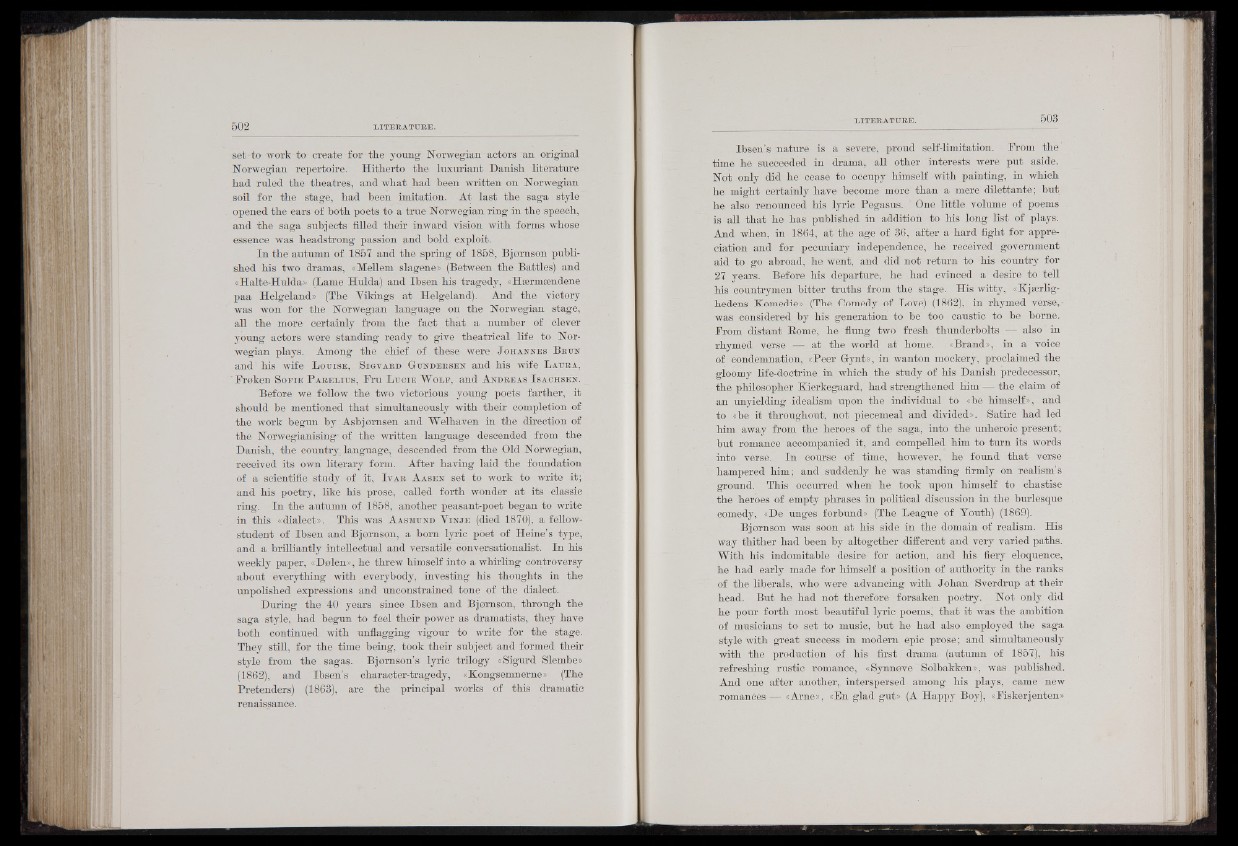
set to work to create for the young Norwegian actors an original
Norwegian repertoire. Hitherto the luxuriant Danish literature
had ruled the theatres, and what had been written on Norwegian
soil for the stage, had been imitation. At last the saga style
opened the ears of both poets to a true Norwegian ring in the speech,
and the saga subjects filled their inward vision with forms whose
essence was headstrong passion and bold exploit.
In the autumn of 1857 and the spring of 1858, Bjarnson published
his two dramas, «Mellem slagene» (Between the Battles) and
«Halte-Hulda» (Lame Hulda) and Ibsen his tragedy, «Hsermsendene
paa Helgeland» (The Vikings at Helgeland). And the victory
was won for the Norwegian language on the Norwegian stage,
all the more certainly from the fact that a number of clever
young actors were standing ready to give theatrical life to Norwegian
plays. Among the chief of these were J o h a n n e s B r u it
and his wife L o u i s e , S ig v a e d G u n d e i i s e n and his wife L a u r a ,
Broken S o f i e P a r e l i u s , Fru L u c i e W o l f , and A n d r e a s I s a c h s e n .
Before we follow the two victorious young poets farther, it
should be mentioned that simultaneously with their completion of
the work begun by Asbjomsen and Welhaven in the direction of
the Norwegianising' of the written language descended from the
Danish, the country language, descended from the Old Norwegian,
received its own literary form. After having laid the foundation
of a scientific study of it, I v a r A a s e n set to work to write it;
and his poetry, like his prose, called forth wonder at its classic
ring. In the autumn of 1858, another peasant-poet began to write
in this «dialect». This was A a s m u n d V i n j e (died 1870), a fellow-
student of Ibsen and Bjarhson, a bom lyric poet of Heine’s type,
and a brilliantly intellectual and versatile conversationalist. In his
weekly paper, «Dolen», he threw himself into a whirling controversy
about everything with everybody, investing his thoughts in the
unpolished expressions and unconstrained tone of the dialect.
During the 40 years since Ibsen and Bjamson, through the
saga style, had begun to feel their power as dramatists, they have
both continued with unflagging vigour to write for the stage.
They still, for the time being, took their subject and formed their
style from the sagas. Bjamson’s lyric trilogy «Sigurd Slembe»
(1862), and Ibsen’s character-tragedy, «Kongsemneme» (The
Pretenders) (1863), are the principal works of this dramatic
renaissance.
Ibsen’s nature is a severe, proud self-limitation. Prom th e ’
time he succeeded in • drama, all other interests were put aside.
Not only did he cease to occupy himself with painting, in which
he might certainly have become more than a mere dilettante; but
he also renounced his lyric Pegasus. One little volume of poems
is all that he has published in addition to his long list of plays.
And when, in 1864, at the age of 36, after a hard fight for appreciation
and for pecuniary independence, he received government
aid to go abroad, he went, and did not return to his country for
27 years. Before his departure, he had evinced a desire to tell
his countrymen bitter truths from the. stage. His witty, «Kjserlig-
hedens Komedie» (The Comedy of Love) (1862), in rhymed verse, -
was considered by his generation to be too caustic to be borne.
Prom distant Borne, he flung two fresh thunderbolts — also in
rhymed verse ¡¡gilat the world at home. «Brand», in a voice
of condemnation, «Peer Gynt», in wanton mockery, proclaimed the
gloomy life-doctrine in which the study of his Danish predecessor,
the philosopher Kierkegaard, had strengthened him — the claim of
an unyielding idealism upon the individual to «be himself», and
to «be it throughout, not piecemeal and divided». Satire had led
him away from the heroes of the saga, into the unheroic present;
but romance accompanied it, and compelled him to turn its words
into verse. In course of time, however, he found that verse
hampered him; and suddenly he was standing firmly on realism’s
ground. This occurred when he took upon himself to chastise
the heroes of empty phrases in political discussion in the burlesque
comedy, «De unges forbund» (The League of Youth) (1869).
Bjornson was soon at his side in the domain of realism. His
way thither had been by altogether different and very varied paths.
With his indomitable desire for action, and his fiery eloquence,
he had early made for himself a position of authority in the ranks
of the liberals, who were advancing with Johan Sverdrup at their
head. But he had not therefore forsaken poetry. Not only did
he pour forth most beautiful lyric poems, that it was the ambition
of musicians to set to music, but he had also employed the saga
style with great success in modem epic prose; and simultaneously
with the production of his first drama (autumn of 1857), his
refreshing rustic romance, «Synnave Solbakken», was published.
And one after another, interspersed among his plays, came new
romances t?r «Arne», «En glad gut» (A Happy Boy), «Fiskerjenten»